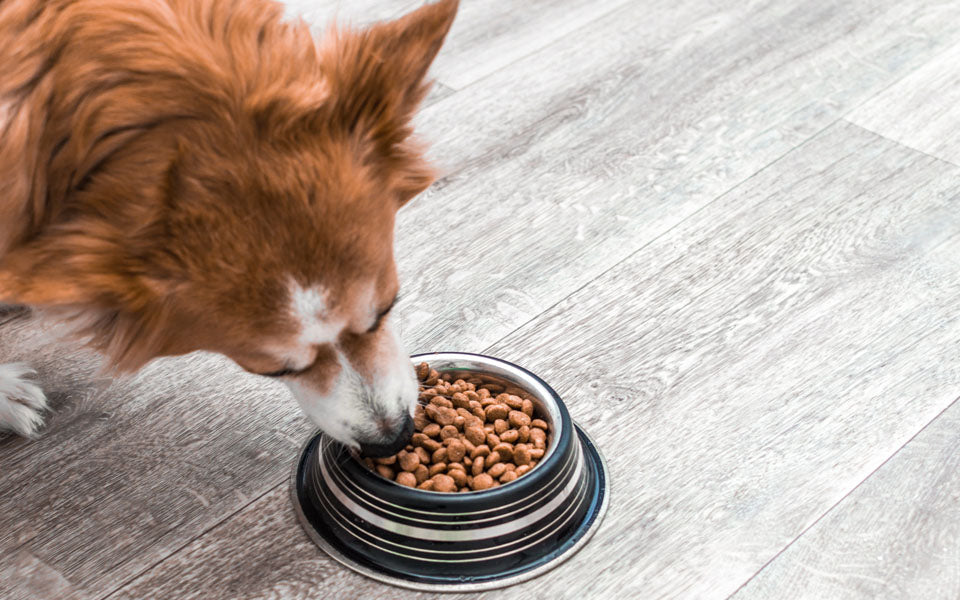
6 Tips to Help Your Dog Gain Weight
Many pet parents can be understandably concerned about their pet’s weight, whether too much weight or too little.
While overweight pets are certainly a major problem in America and could be the topic of an entirely separate article, pets that are underweight shouldn’t go unnoticed.
Perhaps you have a new rescue pup that didn’t come from a good home or care who looks like he could use a little extra meat on his (more prominent) bones.
Or possibly you have a senior pooch who’s been slowing down and experiencing some weight loss to go along with it.
Whatever the reason, it’s important to try to get, and keep, our pets at the most ideal weight possible.
In this article, we’re going to discuss first how to recognize if your dog truly is underweight. Then, we’ll chat about some reasons why dogs may lose weight, including their muscle mass. Finally, we’ll review how to get a dog to gain weight with some strategies to encourage healthy weight gain.
Is Your Dog Actually Underweight?
In America, underweight dogs aren’t a major problem in the average household, at least not more than the normal percentage. In fact, it’s the opposite. According to their last 2018 survey, the Association for Pet Obesity Prevention (APOP) indicates that 56% of dogs are considered overweight or obese.

The high proportion of overweight pets comes with some assumptions. One is that many pet parents out there may not realize how to recognize when their pup has packed on a few too many pounds.
All the way back in 2011, APOP founder veterinarian Dr. Ernie Ward stated that the most concerning thing from data that year wasn’t that over half of pets in the US were overweight or obese. The most concerning thing was that many pet owners were unaware that their pet was overweight.
Dr. Ward relayed from survey data that 22 percent of dog owners characterized their pet as a normal weight when that pooch was actually objectively overweight or obese. He referred to the “normalization” of obesity by pet parents and that “we’ve made fat pets the new normal”.
Also concerning is that back in 2011 52% of dogs were classified as overweight or obese, meaning that in almost 10 years, the percentage has only gone up.
You might be wondering why we’re talking about overweight dogs so much when this article is supposed to be about underweight dogs. The reason is that because obesity in pets is so common in America, our population’s perception of “normal” is skewed. A good percentage of pup parents may look at their dog, who in reality has an ideal, lean body condition, and misjudge her as being too skinny.
I have counseled clients many times over the phone and in appointments when they’re concerned about their dog being too thin because “my friend told me he was too skinny”. I even had one client who’s neighbor called the police on him because they thought he was starving his dog. The dog in question’s body condition? Lean, but ideal and well-muscled for her size and breed.
It’s misperceptions like these that make it important to be sure your pet is actually underweight before you attempt some strategies to get going on weight gain.
While there is a more scientific way to assess how healthy your pup’s weight is which we’ll be discussing next, there is a very helpful chart developed by APOP that has ideal weight ranges listed by dog breed, which can be a good place to start.
How to Score: Body and Muscle Condition
The best way to determine if your dog is an ideal weight--or overweight or underweight--is to use the same tools that veterinarians use everyday--body condition scores and muscle condition scores.
A body condition score consists of assigning a numerical value out of a scale of 1 through 9 with 1 being an extremely thin and emaciated pup to 9 being the most obese. The ideal range is a 4 or 5.
Here’s the general goal. Start by looking at the area just behind your pup’s ribs. From the top, there should be a gentle dip inwards from the last rib to the hips. When looking at her from the side, her belly should slope gently upwards from the last rib to the groin. If your dog loses this “Coke bottle” shape, appears very flat from the last rib back and has no belly tuck at all, she is crossing the line to being overweight.
Generally, while you should be able to feel the last couple of ribs, you shouldn’t be able to see them easily. Dogs that are underweight will also have more prominent pelvic hip bones and an almost concave appearance between the last rib and the hips.
For a chart complete with images and full steps for each numerical score value, see the World Small Animal Veterinary Association Global Nutrition Committee’s body condition score chart
According to the Clinical Nutrition Service at the Cummings Veterinary Medical Center at Tufts University, muscle condition score is an equally important, but sometimes overlooked, component of assessing a pet’s health.
According to their article on assessing muscle condition in pets, many people wrongly assume that a pet has to lose a lot of weight or be very skinny to start losing muscle, but this isn’t true. You actually can have an overweight pet show signs of muscle loss. You can also have a very thin dog that has normal muscling.
Veterinarians at Tufts University developed muscle condition criteria to determine where a dog fits on the muscle loss spectrum. Essentially, a dog losing muscle has either mild, moderate, or severe muscle loss. See the WSAVA muscle condition score chart as developed by Cummings Veterinary Medical Center at Tufts University.
Using these criteria, if you’re still pretty sure your pup is underweight, or if you know this already through conversations with your veterinarian, then it’s time to continue. The next thing to understand is why a pup would be losing weight, especially muscle mass.
Why is My Dog Underweight?
There can be many causes for a dog to be under-conditioned and/or to lose muscle mass. Most of them are medical causes, making it important to find out what condition is responsible for weight loss before just feeding more food.
Here are a few.
Eww, Worms!: Chronic Parasitism
There are several types of intestinal parasites that can contribute to weight loss, with or without any stool issues. These can include, but are not limited to, roundworms, hookworms, whipworms, tapeworms, coccidia, and giardia.
Fortunately, it’s a regular practice in most developed countries to check stool samples at least every year, so we don’t often see pets in good homes with severe disease related to GI parasites.
But if you’ve recently adopted a dog out of a neglectful environment, a hoarding situation, or a pup from a developing country such as in the Caribbean, intestinal parasites have to be on the list as a cause of thin body condition and poor weight gain.
Metabolic and Endocrine Conditions
These are generally conditions that cause a drain on the body’s energy stores and can be diagnosed with labwork at your vet. Metabolic conditions include kidney and liver disease. Endocrine conditions include diabetes and Cushing’s disease.
In any pet that is losing weight, starting with bloodwork often makes the most sense as a screening tool because we can often rule out some of these causes early on.
Gastrointestinal Disease
What we’re talking about here is a collection of disorders affecting the digestive tract that either contribute to poor passage of food or malabsorption of food. This includes conditions like megaesophagus, inflammatory bowel disease and protein-losing enteropathies like lymphangiectasia.
Cancer
Yes, the big “C” word unfortunately has to come up as a possible cause. While not exclusive to older pets, this is more often a rule out for our senior and geriatric dogs. Cancers require (and steal) a lot of energy from the body to grow, which shifts the body into a state of metabolic breakdown, leading to weight loss and especially muscle loss.
This can include cancers of the digestive tract like lymphoma/lymphosarcoma or carcinoma, but really any cancer anywhere in the body will lead to concerning weight loss.
Life Stage and Activity Level
Dogs who are as yet not spayed or neutered can have a higher metabolic rate and may maintain a leaner body condition. Calorie requirements for what we call “intact” dogs like these are typically higher than a spayed or neutered pup.
If you have a dog who performs at a very high level, like police or military working dogs, agility dogs, actively working farm dogs, or just pups who rack up many miles a week trotting alongside their long-distance running parents, it’s important to remember that they also require more daily calories than a dog who just goes for a couple of short walks a day.
These pups may typically look leaner normally because of their high activity level and/or metabolic rate but it’s also important to remember that they have higher caloric needs than the “average” dog.
On the flip side, our older dogs can see some changes too. As we age, we all start to lose muscle mass, it’s just an unfortunate fact of life. The same happens for our senior or geriatric pets. The important thing to remember though is that while aging can lead to weight loss, this process is slow and gradual over time. Bi-annual weight checks at your vet can be helpful to understand how your older pup’s weight is trending.
Older dogs (typically over the age of 7 years) may start to develop decreased energy requirements, sometimes by 10-20% compared to younger dogs. But as we’ll talk about when going over how to figure out feeding amounts based on life stage, the caloric needs for a senior dog still depend largely on activity level, just like they do for a young adult.
Pregnancy and Lactation
This won’t apply to most average pup parents, but it needs to be included as some folks do have active interests in breeding their dogs. Also, accidents are known to happen if an intact male or female dog gets out of the house for a “meet and greet”.
Calorie needs increase in later stages of pregnancy and reach a max during lactation. It requires an immense amount of energy and body stores to create milk to feed hungry puppies and the demands are greater the more puppies there are.
Folks who are inexperienced with the calorie needs associated with pregnancy and lactation may find that their dam’s energy needs are not being met, leading to quickly advancing weight loss. In early stages of pregnancy, energy requirements typically double. They triple in late gestation. After the puppies are born, and depending on how many there are, needs can actually increase by 4-8 times.
If you find yourself in a situation with a pregnant pup or have little experience with breeding, make sure to reach out to your vet. We’re not all repro specialists, but can provide guidance on a safe pregnancy, what to expect, and importantly, how to meet your dog’s feeding requirements during these significant changes.
Underfeeding
I encounter this uncommonly, but it does happen. Some pet parents, all too aware of the problem with obese pets in America, are very strict with food, and sometimes too much so. It also can sometimes happen that you wind up with a very picky eater who eats once a day, maybe skips meals, and before you know it, we’re having trouble keeping weight on.
Every pet food has different calorie amounts and they can sometimes differ by more than 100 kilocalories per cup or can. It’s never appropriate to assume that ½ cup of one food is the same as ½ cup of another food. It’s always important to keep this in mind, especially if you’re transitioning to a new diet or alternating between food choices.
The most important thing to combat underfeeding is to know exactly how many calories your dog needs each day, adjusting for life stage and activity level. In the next section, we’ll go over exactly how to do that.
How Do I Know How Much My Dog Should Be Eating?
It’s really important to be able to answer this question. If you know you’re meeting your dog’s calorie requirements for his life stage and activity level, but we’re still seeing weight loss, this definitely highlights that underfeeding is not the primary cause to be worried about.
It’s also important to know your pup’s calorie needs just so you can keep her at as ideal a weight as possible. This knowledge helps to stave off obesity as well as being underweight.
So how do we figure out our calories and how does this translate into what to feed every day? It’s not a good idea to rely solely on the feeding recommendations on your pup’s bag or cans of food because the range of amounts provided are generic and not catered specifically to your dog’s specific needs.
The simplest way is to use a short formula. Ugh, math. Don’t worry, it’s really easy. I use a slightly more complicated one in practice, but this one will still get you into the same ballpark.
How to Calculate Kilocalories
First, take your dog’s weight in pounds, and convert it to kilograms. To do that, divide the weight in pounds by 2.2.
Next, take the new weight in kilograms and multiply by 30. Last, add 70 to that new total. What you’ll have is an estimate for the calories needed per day, which is called the Resting Energy Requirement, or RER.
Here’s an example.
Let’s say, for simplicity’s sake, that your dog weighs 10 pounds. First, you’ll divide 10 pounds by 2.2, which will give you about 4.5 kilograms. Next, take 4.5 and multiply by 30, giving you 136. Then, add on 70, giving you 206. You can round up to 210 to make further math a little easier.
Translating Kilocalories into Daily Feeding
Now what you need to do to figure out how this translates into feeding amount per day by finding the amount of kilocalories per cup or can on the packaging of your dog’s food. It’s typically found just below the ingredients list.
Divide the amount listed on the bag or can by the daily amount of kilocalories per day that you just calculated and your resulting number will be the amount of cups or cans per day you should be feeding. Using our recent example, let’s say your 10 pound dog is eating a food that is 350 kilocalories per cup. If you divide 350 by 210 you’ll get 1.66, which is 1 and ⅔ cups per day.
Factoring Life Stages and Activity Level
As you might have guessed, a 10 pound puppy does in fact have different nutritional requirements than an adult 10 pound chihuahua. Likewise, a 25lb dog that goes for 3 short walks a day will have lower calorie needs than the 25lb agility athlete.
When you get your final value for daily calories (the 210 you calculated), you can multiply by an appropriate life stage or activity level factor to account for those differences and obtain what is called the Daily Energy Requirement, or DER. This will then be your new, final daily caloric requirement. You might find subtle differences in factors used depending on the source, but these are the ones I use.
Puppy up to 4 months: Multiply by 3.0
Puppy 4 months to Adult Size (typically 12-15months in most breeds): Multiply by 2.0
Spayed or Neutered Adult: Multiply by an activity factor
- Limited Activity (I go outside for a bathroom break but do very little otherwise): No factor (factor of 1.0)
- Light Activity (30 minutes or less focused walks or play activity per day): Factor of 1.5
- Moderate Activity (greater than 30 minutes per day or your typical human companion athlete): Factor of 2.0-3.0
- Heavy Activity (Agility, Working Dogs, Sled Dogs): Factor of 4.0 up to 8.0 depending on activity level (agility might be 4-5, working dogs 5-6, and sled dogs are an easy 8.0 during the on-season).
Senior: Many nutritionists recommend adjusting calories not based on the age of an older pup, but by activity level. If you have a 12 year old dog who still does a few miles a week with you, he may still be just as active as a dog half his age and it wouldn’t make sense to reduce his feeding amounts just because he’s 12.
To Lose Weight: When trying to get a pup to lose weight, I sometimes multiply by a factor of 0.8-1.0, taking into account how active an overweight dog is.
To Gain Weight: When you’re looking to get an underweight dog to gain weight, I typically multiply by a factor of 1.5-2.0, assuming this pup engages in a light level of activity or reduced activity throughout the day. There are more advanced ways of calculating weight loss or gain goals that we sometimes utilize in practice, using a target weight and adjusting feeding amounts using a bell-shaped curve, but I find that starting out with a factor of 2.0 keeps things simple for folks at home to start with.
I will typically set a target weight, recommend increased feeding amounts when appropriate, and then have folks come in for regular weight checks to see where we’re at.
6 Tips to Help Your Dog Gain Weight
Now, after establishing that your pup is truly underweight, and figuring out what her caloric requirements are, your dog needs to gain weight! So let’s help her do that with these 6 tips.
Tip 1: Know the Cause of Weight Loss
We kind of already went into this topic at the beginning, but it’s important to reiterate. If we don’t know the true cause of weight loss or poor weight gain, just feeding more food is unlikely to make enough of a difference.
For example, if we have a pup with a high parasite load of whipworms, we’ve got to treat and get rid of those whipworms before we can expect to see weight gain happen. Otherwise, all of that extra food being fed just goes straight through from one end to the other without being well-absorbed and utilized by the body.
Tip 2: Start with a Calorie-Dense Food
When trying to select a diet to help with weight gain, it’s all about the caloric density of the food, which as mentioned earlier can vary quite a lot.
My general target to simplify things, is to aim for a food that is over 350 kilocalories per cup or typical 13oz. can. This helps prevent against trying to feed an extremely large volume of low calorie density food that your pooch may not be able to finish at a sitting.
Tip 3: Fat and Protein vs. Carbs
Contrary to some popular belief, carbohydrates are not a bad thing. They are one of the three main dietary sources of energy, along with fat and protein, that every living needs for daily function. Carbs are most efficiently broken down into glucose, which is needed by all cells.
However, carbs are a short-duration energy supply and are burned off quickly.
For example, consider the high-energy athlete that engages in “carb-loading” the day before an event. When I was a competitive long-distance runner, it was common to have a pasta dinner the night before a race to provide a supply of burnable energy to be used up the next day.
But if you have a pet that’s losing weight or having trouble keeping weight on, we need a more sustainable source of energy, and while we still need carbs, proteins and fats are far better for this purpose. Dogs engaged in high level endurance activity, like sled dogs, eat a very high calorie diet rich in fats and protein. This provides a slower-burning energy source that also helps to maintain muscle mass.
Many older pets or those suffering from one or more chronic disease conditions that cause them to lose weight, need protein to help keep their muscle on board. There may be some exceptions to this depending on the condition. Certain types of protein may be indicated such as with kidney disease or certain gastrointestinal diseases, which is why it’s very important to consult with your vet to understand your dog’s needs more specifically.
But in general, most pets should have a diet consisting of about 20% protein. Pets with weight concerns likely benefit from higher percentages of high quality protein. To add some additional good quality protein on top of a balanced diet, you can add in cooked egg and fresh cooked meats drained of excess fat and oils like chicken, pork, and beef.
And while the body doesn’t need to get calories from fat to survive (calories from protein and carbs do just fine), calories from fat can be more beneficial than those provided by carbs or protein in cases of high energy demand. This is especially the case when the bulk of food is a factor. A dog can only fill his belly with so much food in a day, so if we have a high energy demand that food needs to be dense in calories and fat can help to accomplish that.
More calorically dense pet foods are likely to be higher in fat. But if looking to supplement extra fats in the diet, make sure to use a healthy proportion. There are good fats and bad fats after all. Omega-6 fatty acids are very abundant in the diet but unfortunately are pro-inflammatory. Omega-3 fatty acids are anti-inflammatory and free-radical scavengers.
Of all the types of oils out there, fish oil has the best levels of DHA and EPA, two crucial Omega-3 fatty acids. Adding a fish oil supplement can be a good way to increase healthy fats in the diet with the added benefits of skin, coat, and joint health.
Keep in mind that adding any oily or greasy human foods can lead to severe digestive upset, like pancreatitis, and high fat diets may not be appropriate for all pets. As already mentioned, make sure to consult with your vet about specific needs your pet may have.
Tip 4: Try Medical Help
It’s very important not to self-diagnose or jump to conclusions about your pet’s cause of weight loss or poor appetite and it’s very important to involve your veterinarian in therapy decisions. It is also up to your veterinarian’s discretion what medication is most medically appropriate to use. However, it can be helpful to have an understanding of what medications we have available to address cases of weight loss and poor appetite to aid in these conversations.
Appetite Stimulants
Depending on the underlying cause, you may find that your pup just isn’t eating as much as she needs to. This may be from an underlying medical condition like we’ve discussed, increased “pickiness”, or a generalized reduced interest with age and less activity.
There are a couple of medications that can help stimulate a pet’s appetite that we use in veterinary practice to help pets either in the short-term or long-term to eat more.
Mirtazapine
Mirtazapine is classified as an antidepressant and serotonin antagonist but is used exclusively as an appetite stimulant. Some of the same chemical mechanisms that classify it as an antidepressant also account for its action in stimulating appetite, and helping with stomach emptying.
It is far more widely used in cats, but when given daily to dogs, can be a very effective and inexpensive way of encouraging eating. It’s generally well-tolerated and side effects are uncommon, but some dogs may develop some mild sedation.
Capromorelin
Capromorelin works by stimulating growth hormone release, creating a feeling of hunger. It can be very effective, with trials showing about a 60% increase in food consumption and a 6% weight gain after one week of use. While uncommon, side effects seen most often in dogs are typically digestive upset.
Anti-Nausea Medications
Not all decreased appetite situations are caused by nausea, but when they are, medications that address this are crucial to include in medical therapy. This can include medications like ondansetron, dolasetron, and maropitant.
Medications aimed at reduced acid production in the stomach, like famotidine and omeprazole, are generally safe to use, but have limited efficacy in serious cases.
In situations involving nausea as related to vertigo-like conditions like vestibular disease which can often affect older dogs quite suddenly, motion sickness medications like meclizine may be recommended.
Steroids
Steroids are not typically used on their own as appetite stimulants, but in some diseases that cause weight loss, like inflammatory bowel disease or certain cancers, they are frequently used and can on their own lead to increased hunger and weight gain.
Unfortunately, steroids can have pronounced side effects in both the short-term and long-term, making them a poor choice for any extended therapy. Much of the time, when steroids are used, there is a goal of reducing their frequency over time while trying to get a different long-term medication on board.
Tip 5: Small, Frequent Meals
Instead of feeding one or two large meals, feed several smaller meals throughout the day. This allows the stomach to take in food, empty, and be ready for more. You might find that you’re more successful feeding your larger daily amount of food needed for weight gain when you spread it out.
Tip 6: Exercise is Still Important
Although going for more walks and jogs is usually associated with weight loss, we’re not necessarily talking about high intensity exercise here. Even just 30 minutes a couple of times a week will keep muscles in shape.
Don’t fall into the trap of limiting exercise to help with weight gain. Restricting activity will actually more likely lead to muscle atrophy and further loss of muscle, making your pup weaker.

Getting Back on the Weight Gain Train
Use this article as guidance to determine if your pet might be underweight or having trouble gaining it. But always make sure to involve your veterinarian with any types of weight concerns.
Remember, with weight loss, it’s very important to know why it’s happening, and your vet is the first place to start to find that out, along with the best place to start with recommendations catered specifically to your pup's needs.








